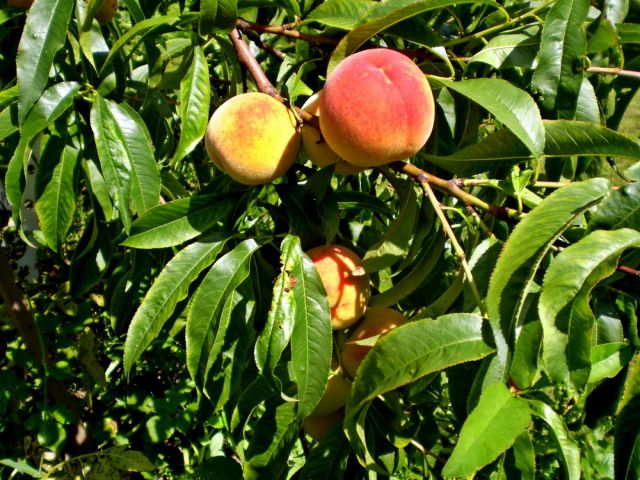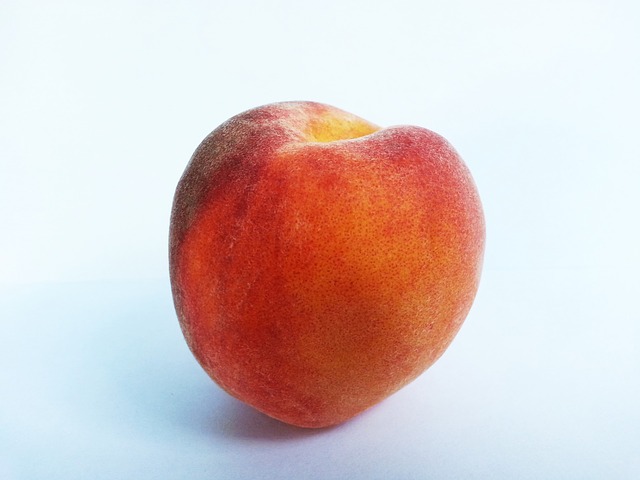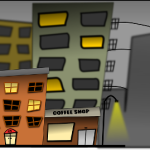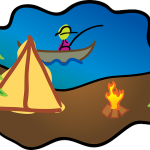PEACH is a simple tool supporters can use when gathering information about a person and their brain injury. It can help to understand the bigger story. PEACH is particularly useful when behaviour is challenging.
First though – a little disclaimer – I know I am always disclaiming myself from something. I just like to be clear.
A Little Disclaimer about PEACH and Gathering Information About Brain Injury:
This tool I am sharing has been used mainly by people working with people with brain injury.
This tool might also be useful as a self directed thingy if you are someone living with brain injury – I have not tested this out. You could give it a go.
If you are family member or friend– same, same – it might be helpful. Feel free to try it out – or you could skip today’s article but please come back next week.
I do hope there is something here for everyone. If it is useful – let me know.
PEACH Described:
The tool not the fruit! The fruit serves well as a delicious acronym here. Personal Environment Activity Communication History:
As a supporter of someone living with brain injury, you sometimes need to gather information about the outcomes of brain injury and the person’s life to enable you provide the best support.
PEACH can help to gather information in a structured and organized way. Particularly helpful at times when events are unstructured, disorganized and maybe even chaotic. It can be used:
[unordered_list style=”green-dot”]
- finding out more about the person not just ‘the brain injury’ picture,
- to gather information when you find yourself without any,
- when you need to find information quickly on the spot,
- or you need a more detailed picture,
- or you don’t have a framework for gathering information,
- you are working on how to resolve a challenging behaviour,
- seeking to fully understand the background to behaviours that are challenging,
- a rounded picture before developing strategies for cognitive outcomes.
[/unordered_list]
PEACH and Gathering Information About Brain Injury
Before gathering any information you need to ensure:
[ordered_list style=”decimal”]
- You are able to do this compassionately, and with empathy.
- That the privacy and confidentiality of the person and their family are maintained and are paramount in your mind.
- You are collecting information to assist the person, not for your own curiosity.
- You have permission to do so.
[/ordered_list]
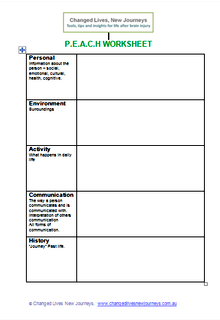 You can print off a free worksheet HERE: Brain Injury-PEACH_Worksheet or click on the worksheet image on the left. Alternatively you can make your own list with these headings:
You can print off a free worksheet HERE: Brain Injury-PEACH_Worksheet or click on the worksheet image on the left. Alternatively you can make your own list with these headings:
Personal
Environment
Activity
Communication
History
Down To The Detail – More About PEACH Gathering Information About Brain Injury
The following are the kinds of things you might want to consider under each heading– again remembering the purpose of gathering any information:
P = Personal
Gain an understanding about the person and their life now. What are the influences and impacts for the person?
Lifestyle – Goals and strengths
Skills and knowledge
Information about the brain injury:
- Cause of brain injury ( traumatic brain injury is more likely to continue to improve whereas a brain injury caused by dementia will continue to change and deteriorate)
- Severity of injury
- Outcomes of brain injury
- Physical changes after brain injury
- Cognitive changes
- Communication difficulties
- Behaviour changes
- Possible Health issues relating to brain injury
- Sensory changes
- Emotional changes
- Social outcomes
Age the injury/illness occured, age now and time since brain injury occurred or began
Previous injuries
Age and stage of life – child, adolescent, older person
Health – current health issues – e.g. infection, fever
Medications – both prescribed and illegal
Disability e.g Mental health issues, intellectual disability
Emotional and Social – Emotional state – happy, sad, grief, depression, anxiety.
Family and Relationships – Family and friend supports
Cultural and Socio-economic factors
Economic and financial
Comfort / Discomfort – Pain, Tiredness, Hunger
E= Environment
Describe in detail the places the person is living and participating in?
This might include:
Where the person is living now – neighbourhood, accommodation style, person’s choice in decisions about accommodation
The kind of places the person attends and for what
Cultural appropriateness
Ambience and aesthetics – sound, light, temperature,
Level of comfort – distracting, noisy, busy, unfamiliar, confusing.
Long and short term changes to the environment e.g. accommodation, daily routine, new people, moving from one activity to another, timetable cancellations or changes.
Surroundings for activities – safe, familiar, appropriate, desired, comfortable.
Appropriate space – it is the correct (or incorrect function) for what is being done e.g. cooking in a kitchen or a dayroom of a hospital.
A = Activity
Discover what the person is engaged in throughout their day.
Type of activity – what is undertaken. Is it appropriate or not. Enjoyed or disliked.
Amount and level of activity – too much, or too little activity, appropriate or inappropriate, challenging, too simple.
Timing of activities – best time of day, and week e.g. weekend / weekday, – too early or too late in the day
Daily routines – appropriate, usual for the person’s age and stage.
Who else is involved in the activity – appropriate, liked, isolated, too hectic.
Ability to interact or not according to choice.
Level of interest in what is happening – motivated or not interested.
Skills are taught in a way that learning can occur – appropriate speed, quantity and level.
Activity or task being done matched with the person’s skills and interest

C = Communication
How does the world communicate with the person and how does the person communicate with the world around them?
Cultural and/or linguistic factors – cultural norms and differences, languages spoken
Impact of Brain Injury on communication – sensory e.g. hearing loss, speech difficulties.
Body language – understood or misinterpreted by the person of others, or others of the person.
Ability to make self understood
Ability to understand verbal and non-verbal communication
Communication delivery by others – too childish,hostile, too complex, not appropriate.
People involved in communication – known or unfamiliar, age appropriate or patronising, liked or not liked.
Style of communication – respectful, patronizing
Social – isolation, friends or no friends.
Instructions and information given – matched to needs, too much information, too complex.
Interpretation of others communication – accurate or misrepresented. Sense of injustice or lack of fairness in what is occurring
Impact of surroundings on communication – noise level
H = History
Gather a biography to round out the picture and help you understand the person and their whole life?
Life before and after brain injury. Lifestyle, life events
Achievements
Family – role and place in family, family history
Cultural background
Age and stage the person was when they had the brain injury and the age and stage they are now.
Personality – pre and post brain injury
Education and work history
Pre-brain injury habits, attitudes, behaviours
Interests, hobbies, leisure, skills.
Other knowledge that relates more directly to brain injury can be important:
- previous drug / alcohol abuse
- previous behaviour difficulties e.g. criminal behaviour,
- learning or other difficulties prior to brain injury
Using PEACH When Gathering Information About Brain Injury
More about this over time but for now, here are some brief suggestions:
[unordered_list style=”tick”]
- Study the information and look for clues for motivators and modifiers when setting goals.
- If it is about behaviour – look for triggers in one or more of the areas (or maybe a combination) – a man did not traditionally cook, in a program to learn food preparation, may trigger frustration or anger.
- Think about the person’s life – what might be impacting on what is happening and what could be changed to work better for the person.
- It is important to gather information sensitively acknowledging the experiences and reactions of the person you are supporting and their family.
[/unordered_list]
And Finally
People living with brain injury have a whole lot of life experiences that they (and supporters) can draw on to rebuild lives, motivate change and develop focused strategies.
A better understanding of a person’s life can give clues about why things might be happening now and what may and may not be effective for that person.
